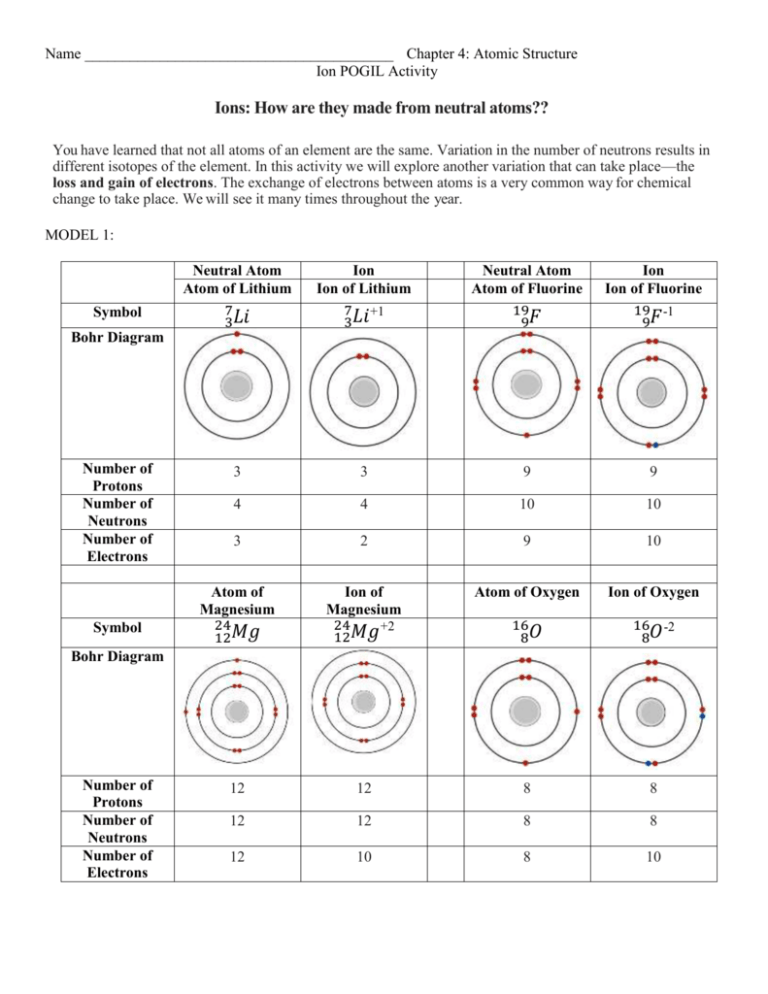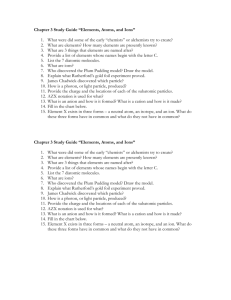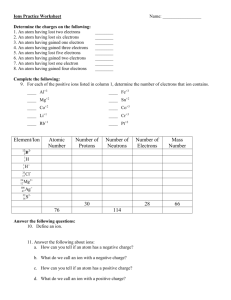Atomic Structure: Ion POGIL Activity
advertisement

Name _________________________________________ Chapter 4: Atomic Structure Ion POGIL Activity Ions: How are they made from neutral atoms?? You have learned that not all atoms of an element are the same. Variation in the number of neutrons results in different isotopes of the element. In this activity we will explore another variation that can take place—the loss and gain of electrons. The exchange of electrons between atoms is a very common way for chemical change to take place. We will see it many times throughout the year. MODEL 1: Symbol Neutral Atom Atom of Lithium 7 3𝐿𝑖 Ion Ion of Lithium 7 +1 3𝐿𝑖 Neutral Atom Atom of Fluorine 19 9𝐹 Ion Ion of Fluorine 19 -1 9𝐹 3 3 9 9 4 4 10 10 3 2 9 10 Atom of Magnesium 24 12𝑀𝑔 Ion of Magnesium 24 +2 12𝑀𝑔 Atom of Oxygen Ion of Oxygen 16 8𝑂 16 -2 8𝑂 12 12 8 8 12 12 8 8 12 10 8 10 Bohr Diagram Number of Protons Number of Neutrons Number of Electrons Symbol Bohr Diagram Number of Protons Number of Neutrons Number of Electrons 1. Use MODEL 1 to complete the following chart: Is the number of Is the number of Is the number of Charge Metal or protons the same in neutrons the same in electrons the same in on the Nonmetal the atom the atom the atom ion and the ion? and the ion? and the ion? Lithium metal 1+ Magnesium metal 2+ Fluorine nonmetal 1– Oxygen nonmetal 2– 2. Based on the table you completed in Question 1, what distinguishes a neutral atom from an ion? 3. Examine the isotope symbols in Model 1. a. Where is the ion charge located in the isotope symbol? b.Is a charge indicated on the neutral atoms? If yes, where is it located? 4. Which subatomic particle carries a positive charge? 5. Which subatomic particle carries a negative charge? 6. Propose a mathematical equation to calculate the charge on an ion from the number of protons and electrons in an ion. Confirm that your equation works using two positive ion examples and two negative ion examples from Model 1. READ THIS: Chemists refer to positively charged ions as cations. Chemists refer to negatively charged ions as anions. 7. Fill in the following table: Symbol 88 +2 38𝑆𝑟 32 -2 16𝑆 19 Atomic Number Mass Number 35 Number of Protons 17 Number of Electrons 18 Number of Neutrons 18 20 Cation or Anion 8. Could a +3 ion of aluminum be made by adding three protons to a neutral atom? Explain. 9. One of your classmates is having trouble understanding ions. He explains the formation of a cation like this: “When you add an electron, you get a positive charge because adding is positive in math.” a. As a group, explain in a grammatically correct sentence why this student is incorrect. b. Provide a better description of how math relates to electrons and ion formation. 10.Why do neutral atoms want to lose or gain electrons and become ions? READ THIS: When looking at the Periodic Table: Metals appear to the LEFT of the staircase. Nonmetals appear to the RIGHT of the staircase. 11. Consider the ions listed in Model 2. a. In general, do nonmetals form anions or cations? b. In general, do metals form anions or cations? c. Which nonmetal appears to be an exception to these guidelines?







